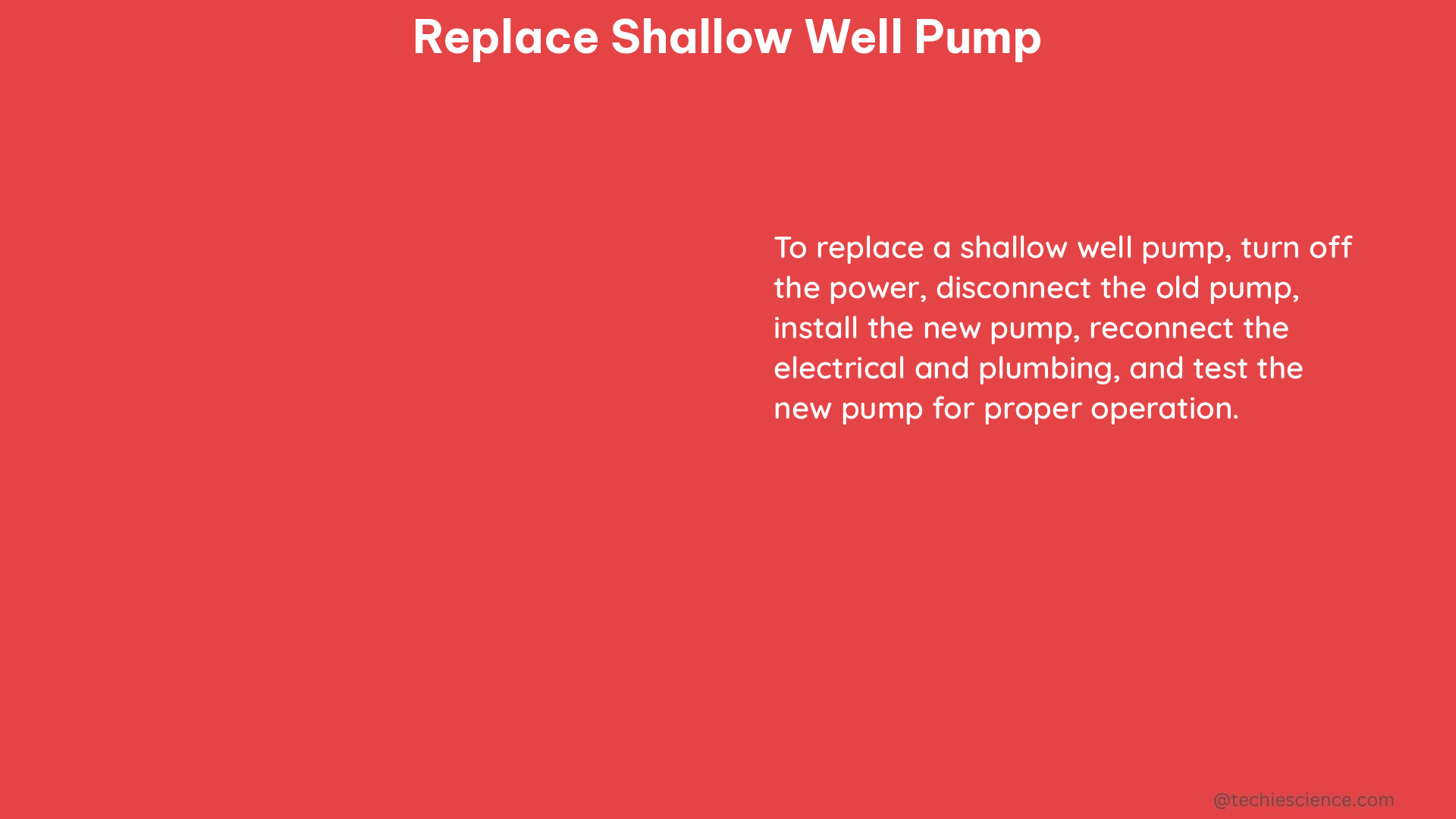Replacing a shallow well pump can be a daunting task, but with the right knowledge and preparation, it can be a straightforward process. This comprehensive guide will walk you through the key considerations and steps involved in replacing a shallow well pump, ensuring a successful and efficient installation.
Understanding Shallow Well Pumps
Shallow well pumps are designed to draw water from wells that are typically less than 25 feet deep. These pumps are often used in residential and small-scale agricultural settings, where the water table is relatively close to the surface. Shallow well pumps can be either jet pumps or submersible pumps, each with its own unique characteristics and installation requirements.
Assessing Your Well Depth and Pump Type

The first step in replacing a shallow well pump is to determine the depth of your well and the type of pump currently installed. This information will guide you in selecting the appropriate replacement pump and ensuring a proper fit.
Well Depth Measurement
To measure the depth of your well, you can use a weighted tape measure or a well depth sounder. Lower the tape or sounder into the well until it reaches the water level, and then read the measurement. This will give you the exact depth of your well, which is crucial for selecting the right pump and pump cable length.
Pump Type Identification
Shallow well pumps can be either jet pumps or submersible pumps. Jet pumps are installed above ground and use suction to draw water from the well, while submersible pumps are installed inside the well and use pressure to push water to the surface. Carefully inspect your existing pump to determine its type and ensure that you select a replacement that is compatible with your well setup.
Selecting the Appropriate Replacement Pump
Once you have determined the depth of your well and the type of pump currently installed, you can begin the process of selecting the appropriate replacement pump. Consider the following factors:
Pump Horsepower
The horsepower of the pump will determine its flow rate and pressure. For a shallow well, a 1/2 to 1 horsepower pump is typically sufficient, delivering between 5 and 10 gallons per minute (GPM) at 30 to 50 pounds per square inch (PSI).
Pump Voltage
Most shallow well pumps require either 110-120 volts or 220-240 volts. Ensure that the replacement pump is compatible with your home’s electrical system.
Pump Cable Length
The length of the pump cable must be sufficient to reach the bottom of the well. As a general rule, the cable should be at least 10 feet longer than the well depth to allow for proper installation and future maintenance.
Pressure Tank Size
The size of the pressure tank will determine how long the pump can run before shutting off. A larger pressure tank (e.g., 40 gallons) can store more water, allowing the pump to run less frequently and extend its lifespan.
Preparing for the Replacement Process
Before you begin the replacement process, ensure that you have all the necessary tools and equipment on hand, including:
- Adjustable wrenches
- Pliers
- Screwdrivers
- Pipe wrenches
- Teflon tape
- Electrical tape
- Pump cable
- Pressure tank (if needed)
Additionally, make sure to turn off the power to the existing pump and follow all safety guidelines to prevent electrical hazards.
Replacing the Shallow Well Pump
The process of replacing a shallow well pump can vary depending on the specific pump type and well setup, but generally, it involves the following steps:
- Disconnect the power supply to the existing pump.
- Remove the well cap or seal and access the pump.
- Disconnect the pump from the plumbing and electrical connections.
- Carefully remove the existing pump from the well.
- Lower the new pump into the well, ensuring that the pump cable is properly secured and routed.
- Reconnect the plumbing and electrical connections, following the manufacturer’s instructions.
- Prime the pump and check for any leaks or issues.
- Restore power to the pump and test its operation.
- Sanitize the well by disinfecting the well casing and pump components.
Maintaining Your Shallow Well Pump
To ensure the longevity and optimal performance of your shallow well pump, it’s essential to perform regular maintenance. This includes:
- Checking the pressure tank and adjusting the air pressure as needed
- Inspecting the pump and plumbing for any signs of wear or damage
- Cleaning the pump and well components to prevent buildup of sediment or debris
- Monitoring the pump’s performance and addressing any issues promptly
By following these guidelines and maintaining your shallow well pump, you can ensure a reliable and efficient water supply for your home or property.
Conclusion
Replacing a shallow well pump can be a straightforward process, but it requires careful planning and attention to detail. By understanding the key factors involved, selecting the appropriate replacement pump, and following proper installation and maintenance procedures, you can ensure a successful and long-lasting shallow well pump installation.
References:
- Replacing Shallow Well Jet Pump | DIY Home Improvement Forum
- Diagnose and Replace a Submersible Well Pump – Instructables
- How to Replace a Submersible Well Pump. Step by Step – YouTube

The lambdageeks.com Core SME Team is a group of experienced subject matter experts from diverse scientific and technical fields including Physics, Chemistry, Technology,Electronics & Electrical Engineering, Automotive, Mechanical Engineering. Our team collaborates to create high-quality, well-researched articles on a wide range of science and technology topics for the lambdageeks.com website.
All Our Senior SME are having more than 7 Years of experience in the respective fields . They are either Working Industry Professionals or assocaited With different Universities. Refer Our Authors Page to get to know About our Core SMEs.